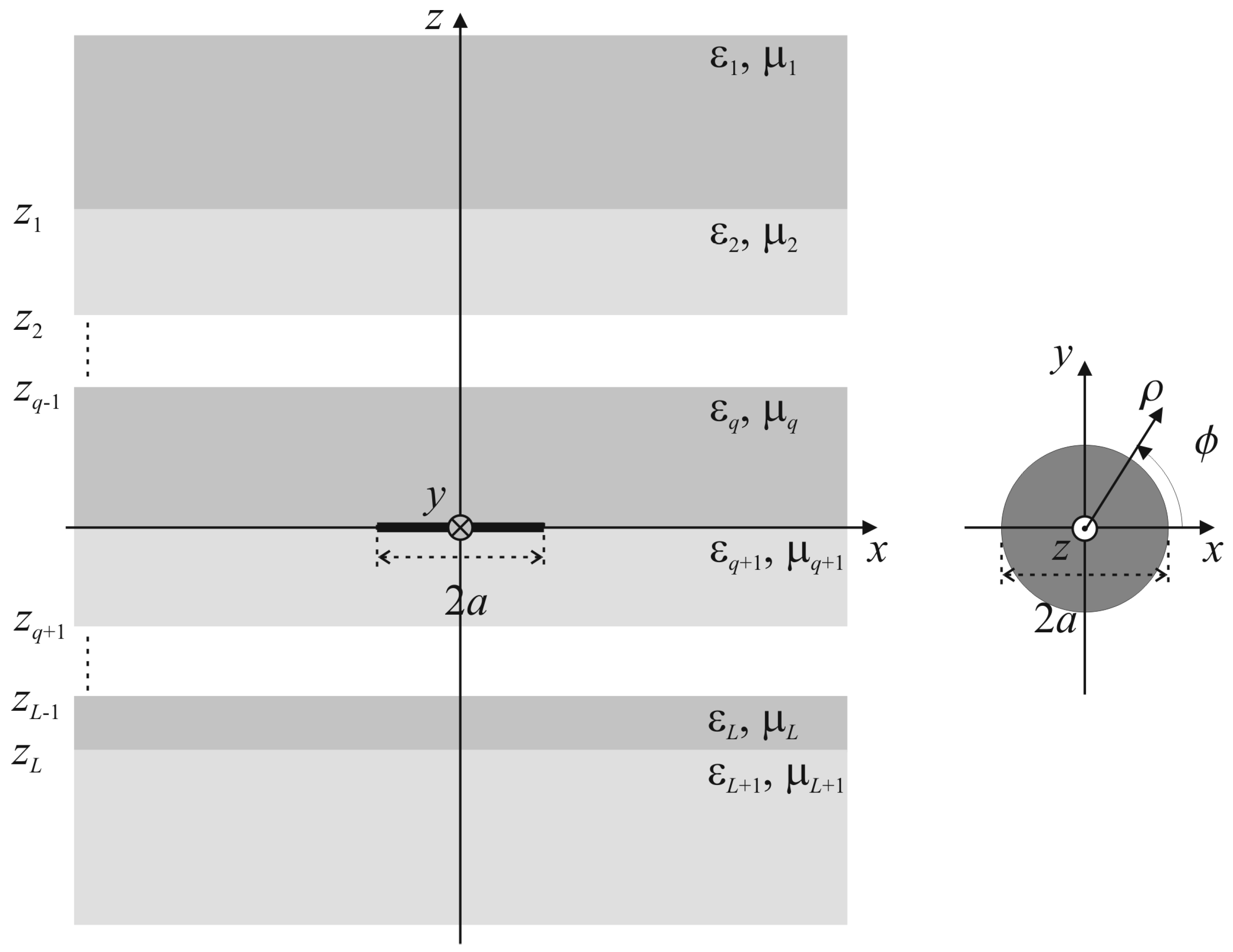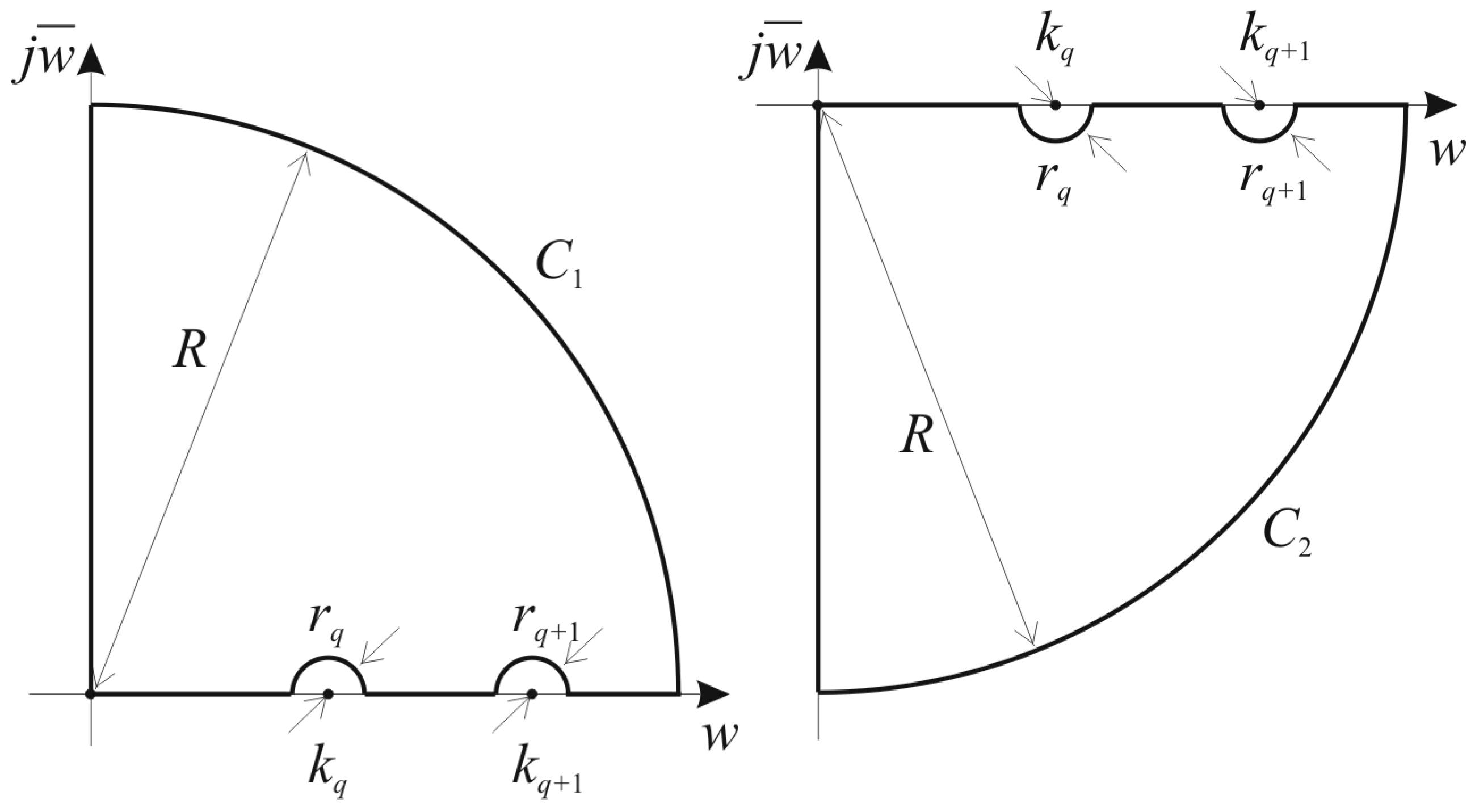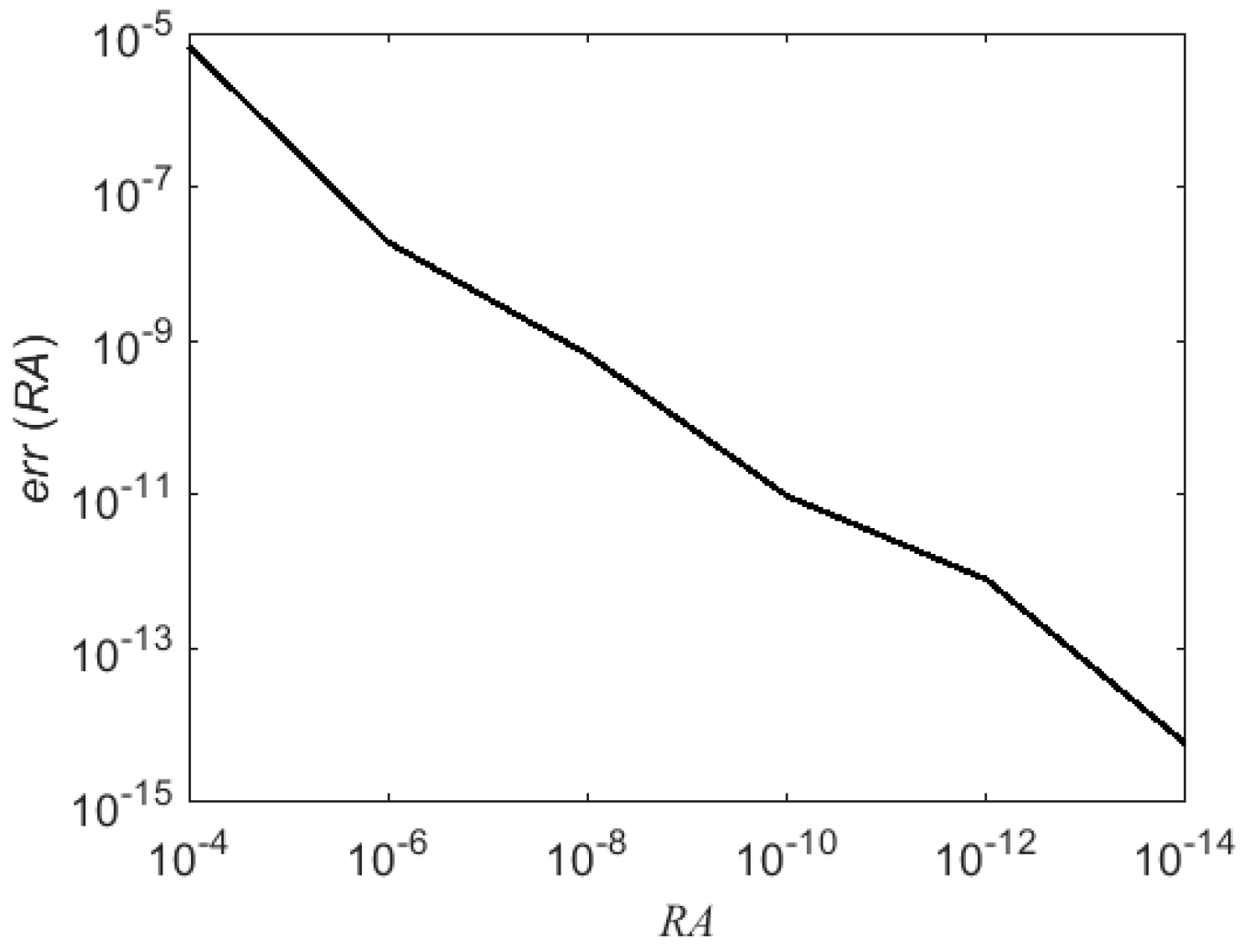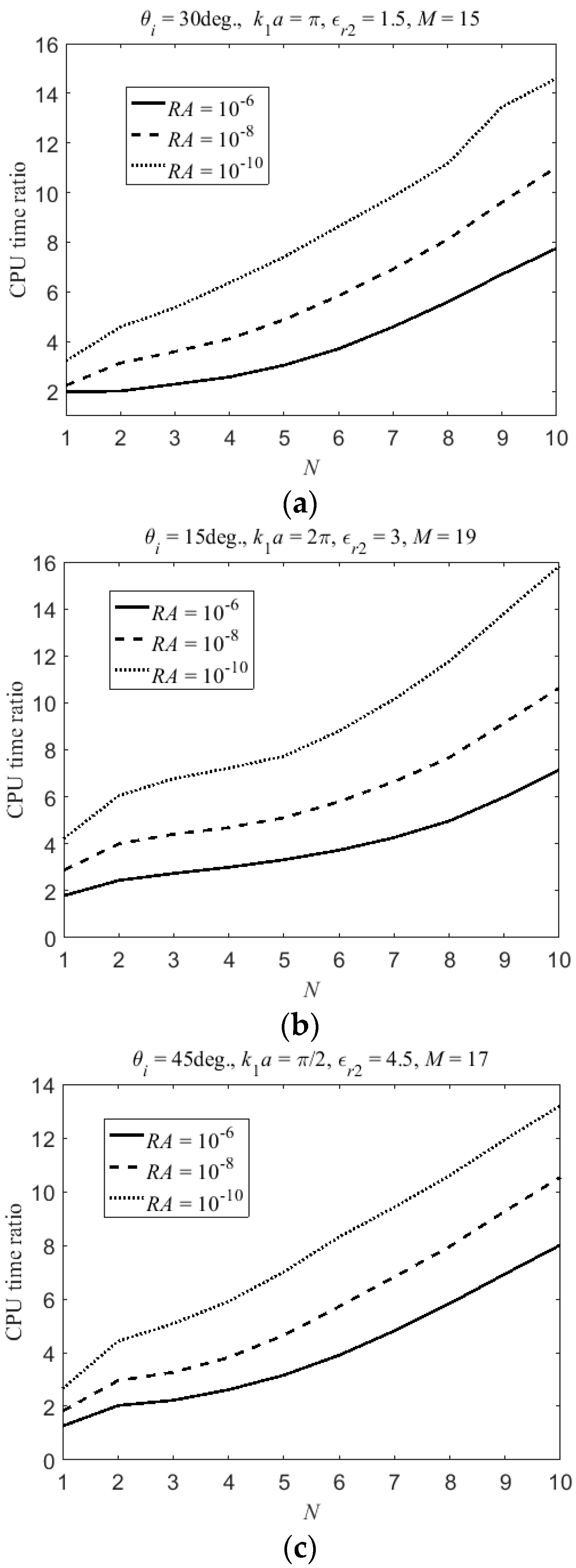Efficient Evaluation of Slowly Converging Integrals Arising from MAP Application to a Spectral-Domain Integral Equation
Abstract
1. Introduction
2. Problem Formulation and Solution
2.1. Spectral-Domain Integral Equation
2.2. Discretization Procedure
3. Analytical Technique for Accurate and Efficient Evaluation of Scattering Matrix Coefficients
4. Results and Discussion
5. Conclusions
Author Contributions
Funding
Conflicts of Interest
References
- Jones, D.S. The Theory of Electromagnetism; Pergamon Press: New York, NY, USA, 1964. [Google Scholar]
- Colton, D.; Kress, R. Integral Equation Methods in Scattering Theory; Wiley: New York, NY, USA, 1983. [Google Scholar]
- Mittra, R.; Klein, C.A. Stability and convergence of moment method solution. In Numerical and Asymptotic Techniques in Electromagnetics; Mittra, R., Ed.; Springer-Verlag: New York, NY, USA, 1975. [Google Scholar]
- Dudley, D.G. Error minimization and convergence in numerical methods. Electromagnetics 1985, 5, 89–97. [Google Scholar] [CrossRef]
- Reed, M.; Simon, B. Methods of Mathematical Physics I: Functional Analysis; Academic Press: San Diego, CA, USA, 1980. [Google Scholar]
- Steinberg, S. Meromorphic Families of Compact Operators. Arch. Ration. Mech. Anal. 1968, 31, 372–379. [Google Scholar] [CrossRef]
- Kantorovich, L.V.; Akilov, G.P. Functional Analysis, 2nd ed.; Pergamon Press: Oxford, UK; Elmsford, NY, USA, 1982. [Google Scholar]
- Contopanagos, H.; Dembart, B.; Epton, M.; Ottusch, J.J.; Rokhlin, V.; Visher, J.L.; Wandzura, S.M. Well-conditioned boundary integral equations for three-dimensional electromagnetic scattering. IEEE Trans. Antennas Propag. 2002, 50, 1824–1830. [Google Scholar] [CrossRef]
- Liu, Z.; Adams, R.J.; Carin, L. Well-conditioned MLFMA formulation for closed PEC targets in the vicinity of a half space. IEEE Trans. Antennas Propag. 2003, 51, 2822–2829. [Google Scholar]
- Borel, S.; Levadoux, D.P.; Alouges, F. A new well-conditioned integral formulation for Maxwell equations in three dimensions. IEEE Trans. Antennas Propag. 2005, 53, 2995–3004. [Google Scholar] [CrossRef]
- Nosich, A.I. Method of analytical regularization in computational photonics. Radio Sci. 2016, 51, 1421–1430. [Google Scholar] [CrossRef]
- Sologub, V.G. Short-wave asymptotic behaviour of the solution of the problem of diffraction by a circular disk. USSR J. Comput. Maths. Mathem. Phys. (Engl. Transl.) 1972, 12, 135–164. [Google Scholar] [CrossRef]
- Dunai, B.A.; Lugovoi, A.V.; Sologub, V.G. Scattering of electromagnetic waves by a disk at the boundary of a dielectric half-space. Sov. Phys. Tech. Phys. 1975, 20, 1396–1398. [Google Scholar]
- Eswaran, K. On the solutions of a class of dual integral equations occurring in diffraction problems. Proc. Roy. Soc. A 1990, 429, 399–427. [Google Scholar] [CrossRef]
- Veliev, E.I.; Veremey, V.V. Numerical-analytical approach for the solution to the wave scattering by polygonal cylinders and flat strip structures. In Analytical and Numerical Methods in Electromagnetic Wave Theory; Hashimoto, M., Idemen, M., Tretyakov, O.A., Eds.; Science House: Tokyo, Japan, 1993; pp. 471–514. [Google Scholar]
- Bliznyuk, N.Y.; Nosich, A.I.; Khizhnyak, A.N. Accurate computation of a circular-disk printed antenna axisymmetrically excited by an electric dipole. Microw. Opt. Technol. Lett. 2000, 25, 211–216. [Google Scholar] [CrossRef]
- Lucido, M.; Migliore, M.D.; Pinchera, D. A new analytically regularizing method for the analysis of the scattering by a hollow finite-length PEC circular cylinder. Prog. Electromagn. Res. B 2016, 70, 55–71. [Google Scholar] [CrossRef]
- Davis, M.J.; Scharstein, R.W. Electromagnetic plane wave excitation of an open-ended finite-length conducting cylinder. J. Electromagn. Waves Appl. 1993, 7, 301–319. [Google Scholar] [CrossRef]
- Hongo, K.; Serizawa, H. Diffraction of electromagnetic plane wave by rectangular plate and rectangular hole in the conducting plate. IEEE Trans. Antennas Propag. 1999, 47, 1029–1041. [Google Scholar] [CrossRef]
- Tsalamengas, J.L. Rapidly converging direct singular integral-equation techniques in the analysis of open microstrip lines on layered substrates. IEEE Trans. Microw. Theory Tech. 2001, 49, 555–559. [Google Scholar] [CrossRef]
- Losada, V.; Boix, R.R.; Medina, F. Fast and accurate algorithm for the short-pulse electromagnetic scattering from conducting circular plates buried inside a lossy dispersive halfspace. IEEE Trans. Geosci. Remote Sens. 2003, 41, 988–997. [Google Scholar] [CrossRef]
- Hongo, K.; Naqvi, Q.A. Diffraction of electromagnetic wave by disk and circular hole in a perfectly conducting plane. Prog. Electromagn. Res. 2007, 68, 113–150. [Google Scholar] [CrossRef]
- Corsetti, F.; Lucido, M.; Panariello, G. Effective analysis of the propagation in coupled rectangular-core waveguides. IEEE Photon Technol. Lett. 2014, 26, 1855–1858. [Google Scholar] [CrossRef]
- Lucido, M.; Santomassimo, C.; Panariello, G. The method of analytical preconditioning in the analysis of the propagation in dielectric waveguides with wedges. J. Lightw. Technol. 2018, 36, 2925–2932. [Google Scholar] [CrossRef]
- Park, S.; Balanis, C.A. Dispersion characteristics of open microstrip lines using closed-form asymptotic extraction. IEEE Trans. Microw. Theory Tech. 1997, 45, 458–460. [Google Scholar] [CrossRef]
- Park, S.; Balanis, C.A. Closed-form asymptotic extraction method for coupled microstrip lines. IEEE Microw. Guid. Wave Lett. 1997, 7, 84–86. [Google Scholar] [CrossRef]
- Amari, S.; Vahldieck, R.; Bornemann, J. Using selective asymptotics to accelerate dispersion analysis of microstrip lines. IEEE Trans. Microw. Theory Tech. 1998, 46, 1024–1027. [Google Scholar] [CrossRef]
- Celozzi, S.; Panariello, G.; Schettino, F.; Verolino, L. Analysis of the induced currents in finite size PCB ground planes. Electr. Eng. 2001, 83, 1–5. [Google Scholar] [CrossRef]
- Lucido, M. An analytical technique to fast evaluate mutual coupling integrals in spectral domain analysis of multilayered coplanar coupled striplines. Microw. Opt. Technol. Lett. 2012, 54, 1035–1039. [Google Scholar] [CrossRef]
- Lucido, M. A new high-efficient spectral-domain analysis of single and multiple coupled microstrip lines in planarly layered media. IEEE Trans. Microw. Theory Tech. 2012, 60, 2025–2034. [Google Scholar] [CrossRef]
- Lucido, M. An efficient evaluation of the self-contribution integrals in the spectral-domain analysis of multilayered striplines. IEEE Antennas Wirel. Propag. Lett. 2013, 12, 360–363. [Google Scholar] [CrossRef]
- Coluccini, G.; Lucido, M. A new high efficient analysis of the scattering by a perfectly conducting rectangular plate. IEEE Trans. Antennas Propag. 2013, 61, 2615–2622. [Google Scholar] [CrossRef]
- Lucido, M. Electromagnetic scattering by a perfectly conducting rectangular plate buried in a lossy half-space. IEEE Trans. Geosci. Remote Sens. 2014, 52, 6368–6378. [Google Scholar] [CrossRef]
- Lucido, M. Scattering by a tilted strip buried in a lossy half-space at oblique incidence. Prog. Electromagn. Res. M 2014, 37, 51–62. [Google Scholar] [CrossRef][Green Version]
- Lucido, M.; Santomassimo, C.; Schettino, F.; Migliore, M.D.; Pinchera, D.; Panariello, G. TM electromagnetic scattering from PEC polygonal cross-section cylinders: A new analytical approach for the efficient evaluation of improper integrals involving oscillating and slowly decaying functions. Adv. Math. Phys. 2019, 2019, 7902836. [Google Scholar] [CrossRef]
- Lucido, M.; Schettino, F.; Panariello, G. Scattering from a thin resistive disk: A guaranteed fast convergence technique. IEEE Trans. Antennas Propag. under review.
- Chew, W.C.; Kong, J.A. Resonance of nonaxial symmetric modes in circular microstrip disk antenna. J. Math. Phys. 1980, 21, 2590–2598. [Google Scholar] [CrossRef]
- Balaban, M.V.; Sauleau, R.; Benson, T.M.; Nosich, A.I. Dual integral equations technique in electromagnetic scattering by a thin disk. Prog. Electromagn. Res. B 2009, 16, 107–126. [Google Scholar] [CrossRef]
- Lucido, M.; Panariello, G.; Schettino, F. Scattering by a zero-thickness PEC disk: A new analytically regularizing procedure based on Helmholtz decomposition and Galerkin method. Radio Sci. 2017, 52, 2–14. [Google Scholar] [CrossRef]
- Abramowitz, M.; Stegun, I.A. Handbook of Mathematical Functions; Dover Publications, Inc.: New York, NY, USA, 1974. [Google Scholar]
- Chew, W.C. Waves and Fields in Inhomogeneous Media; IEEE Press: New York, NY, USA, 1995. [Google Scholar]
- Chew, W.C.; Chen, S.Y. Response of a point source embedded in a layered medium. IEEE Antennas Wirel. Propag. Lett. 2003, 2, 254–258. [Google Scholar] [CrossRef][Green Version]
- Wilkins, J.E. Neumann series of Bessel functions. Trans. Amer. Math. Soc. 1948, 64, 359–385. [Google Scholar] [CrossRef]
- Gradstein, S.; Ryzhik, I.M. Tables of Integrals, Series and Products, 7th ed.; Academic Press: New York, NY, USA, 2007. [Google Scholar]
- Rudin, W. Real and Complex Analysis, 3rd ed.; McGraw-Hill Book Co.: Singapore, 1987. [Google Scholar]
- Geng, N.; Carin, L. Wide-band electromagnetic scattering from a dielectric BOR buried in a layered lossy dispersive medium. IEEE Trans. Antennas Propag. 1999, 47, 610–619. [Google Scholar] [CrossRef]





| N | Jρ (a/3,0) |
|---|---|
| 1 | 1.0232944830856130 + j1.615929348538852 |
| 2 | 0.9402175664195258 + j2.040051164392425 |
| 3 | 0.9299416666965759 + j2.082591420310117 |
| 4 | 0.9295821767452994 + j2.084315713323187 |
| 5 | 0.9295769410471458 + j2.084336809685750 |
| 6 | 0.9295769115416499 + j2.084336239685073 |
| 7 | 0.9295769115444337 + j2.084336215109854 |
| 8 | 0.9295769115443534 + j2.084336214722596 |
| 9 | 0.9295769115443640 + j2.084336214719673 |
| 10 | 0.9295769115443642 + j2.084336214719671 |
| 11 | 0.9295769115443642 + j2.084336214719671 |
| RA | Jρ (a/3,0) |
|---|---|
| 10−4 | 0.9295672270564749 + j2.084324032066043 |
| 10−6 | 0.9295768771544162 + j2.084336241777618 |
| 10−8 | 0.9295769129970962 + j2.084336214286492 |
| 10−10 | 0.9295769115654842 + j2.084336214725778 |
| 10−12 | 0.9295769115442899 + j2.084336214717872 |
| 10−14 | 0.9295769115443696 + j2.084336214719659 |
| Presented Technique | 0.9295769115443642 + j2.084336214719671 |
© 2019 by the authors. Licensee MDPI, Basel, Switzerland. This article is an open access article distributed under the terms and conditions of the Creative Commons Attribution (CC BY) license (http://creativecommons.org/licenses/by/4.0/).
Share and Cite
Lucido, M.; Migliore, M.D.; Nosich, A.I.; Panariello, G.; Pinchera, D.; Schettino, F. Efficient Evaluation of Slowly Converging Integrals Arising from MAP Application to a Spectral-Domain Integral Equation. Electronics 2019, 8, 1500. https://doi.org/10.3390/electronics8121500
Lucido M, Migliore MD, Nosich AI, Panariello G, Pinchera D, Schettino F. Efficient Evaluation of Slowly Converging Integrals Arising from MAP Application to a Spectral-Domain Integral Equation. Electronics. 2019; 8(12):1500. https://doi.org/10.3390/electronics8121500
Chicago/Turabian StyleLucido, Mario, Marco Donald Migliore, Alexander I. Nosich, Gaetano Panariello, Daniele Pinchera, and Fulvio Schettino. 2019. "Efficient Evaluation of Slowly Converging Integrals Arising from MAP Application to a Spectral-Domain Integral Equation" Electronics 8, no. 12: 1500. https://doi.org/10.3390/electronics8121500
APA StyleLucido, M., Migliore, M. D., Nosich, A. I., Panariello, G., Pinchera, D., & Schettino, F. (2019). Efficient Evaluation of Slowly Converging Integrals Arising from MAP Application to a Spectral-Domain Integral Equation. Electronics, 8(12), 1500. https://doi.org/10.3390/electronics8121500









